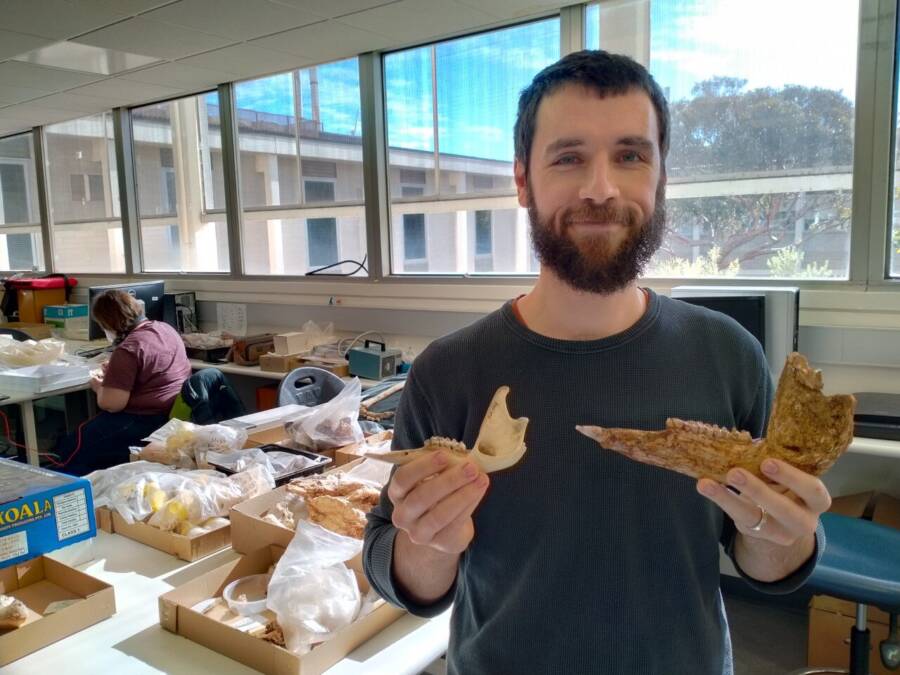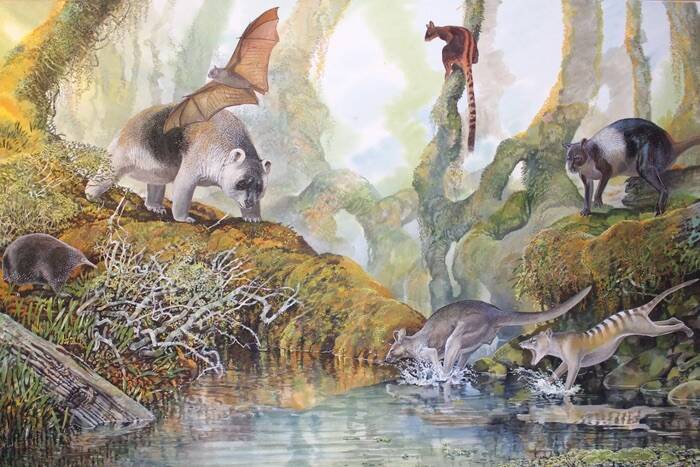Scientists used to believe that the massive Nombe nombe was a relative of Australia's prehistoric kangaroos — but now they know it was a genus all its own.

Flinders UniversityFlinders University paleontology researcher Isaac Kerr with an Australian kangaroo jaw bone, and the fossil jaw used in the study.
Paleontologists studying the Chimbu Province region in the mountains of central Papua New Guinea have made a gargantuan discovery — a fossil of a genus of giant kangaroo that went extinct 42,000 years ago.
But these creatures are less related to modern-day kangaroos than they are to a primitive genus that is — so far — unique to Papua New Guinea.
Using 3D imagery and other technology, researchers from Flinders University in Australia have been able to more dynamically study two, 20,000-50,000-year-old jaws of the extinct kangaroo that were originally found in the 1970s.
As of yet, these are the only evidence of the ancient genus.
Described in the journal Transactions of the Royal Society of South Australia, this creature was not a species of the genus Protemnodon, which used to live all over Australia and is closely related to the modern kangaroos there — but that it was instead something a lot older and more mysterious.
Named Nombe nombe for the Nombe Rockshelter in Chimbu Province where it was initially found, these strange kangaroos roamed the thick undergrowth of prehistoric New Guinea alongside similarly massive creatures known as megafauna.
Indeed, at the Nombe Rockshelter, multiple extinct species of kangaroo and giant four-legged marsupials called diprotodontids have been discovered over the decades. And although Nombe nombe is a genus of kangaroo all its own, it’s no coincidence that it has similarities with Australia’s kangaroos.
That’s because Nombe nombe may have evolved from an ancient species of kangaroo that migrated into New Guinea from Australia about five to eight million years ago when the two landmasses were connected by a land bridge. According to Science Alert, rising sea levels eventually separated the two.

Flinders UniversityA 3D rendering of Nombe nombe‘s jaw.
But species that seem to mirror each other in New Guinea and Australia persist, even today. “The New Guinean fauna is fascinating,” Flinders paleontology Ph.D. candidate Isaac Kerr told Phys.org.
“There are several species of large, long-nosed, worm-eating echidna that are still around today, many different wallaby and possum species that we don’t get in Australia, and more still in the fossil record. We think of these animals as being uniquely Australian, but they have this intriguing other life within New Guinea.”
When Nombe nombe branched off from the kangaroos in Australia, it evolved in ways to better survive its new, tropical mountain home. It evolved a powerful jaw and facial muscles to feast on the land’s tough shrubs and leaves.
Nombe nombe was also likely squat and muscular — but little else is known about its habitat or behaviors, or how comparable it was to the extinct mega-kangaroo Protemnodon from Australia.
This beast is thought to have looked like a modern-day wallaby, but it was altogether larger. The smallest in the genus weighed in at about 100 pounds while the largest was probably around 400 pounds. Whether the Nombe nombe was anything like the wallaby or hopped like modern kangaroos remains unknown.
Additionally, why these creatures went extinct at all remains a mystery.

Illustration by Peter SchoutenA depiction of prehistoric Papua New Guinea’s flora and megafauna.
Of course, as with any prehistoric discovery, more questions than answers have arisen. As such, the team from Flinders University will return to Papua New Guinea for further excavations next year.
“We’re very excited to undertake three paleontological digs at two different sites in eastern and central PNG over the next three years,” reports co-author and Flinders University Professor Gavin Prideaux to Eureakalert.
Kerr is optimistic that this upcoming research will “breathe some new life into paleontology in New Guinea” and that “there may even be a complete skeleton of Nombe nombe waiting for us.”
For more news out of prehistory, check out the mind-boggling discovery of a 95-million-year-old crocodile found with a dinosaur still in its belly. Then, learn more about ancient Australia’s megafauna with Thapunngaka shawi, the giant flying reptile that resembled a dragon.





